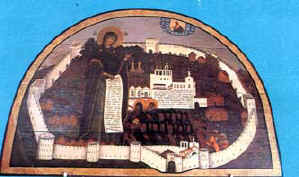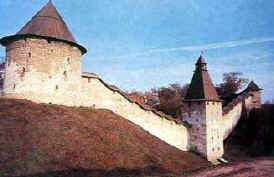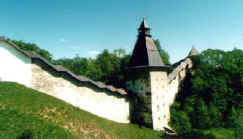The
small Russian town of Pechory.
Pechorsky
monastery, fortress of the 16 century, caves.
The
small town of Pechory (In English does mean Caves), a local center, is situated near the Estonian border 53 kilometers from Pskov.


The main attraction of the town is the Holy-Pechory Assumption Orthodox
Monastery of the caves, the oldest in Russia, being the monument of
russian culture and military history. Originally located in the caves, the
monastery gave the name to the town (in ancient Russian language
"cave" sounded like "pechera".
The date of the monastery foundation is considered to be August 28, 1473.
On that day the monastery's founder, Saint Jonah (Shestnik)
consecrated the Cathedral of the Dormishion of the Most Holy Mother of
God, a church which was dug out of the hillside.
The monastery particularly flourished during the 16 century under Father
Superior Cornelius. During those years a lot the monastery's buildings
were erected and the monastery was fortified around by a stone wall with
bastions. Slandered by envious people, Father Superior Cornelius was
betrayed and finally beheaded by Tsar Ivan the Terrible on the 20th of
February, 1570, and now numbers among the hosts of Saint-Martyrs.
The preparation for the Livonian war (1558 - 1583) led to the requirement
to strengthen the border monastery. Most of the majestic and vigorous
stone walls and towers of the monastery were built during 1560.
From the late 16 th to the early 18 th century the monastery was
repeatedly besiege by the Swedes, Poles and Lithuanians.
During its military history the fortress only once was captured by the
enemy, but in a day the enemy was banished by the courage and steadfast
people.
At the beginning of Northern War (1701) Peter the Great visited the
Pechory monastery. Foreseeing the use of fortress in military fights he
ordered to strengthen it with earth walls, rolls, banks and ditches.
The military activity of the monastery-fortress finished with the
conclusion of Nishtadt peace treaty in 1721. 140 years the fortress
defended the borders of Russia. But till now it is a wonderful monument of
Russian fortification Art.
 The contemporary appearance of the monastery is unusually picturesque. The
fortress walls surround the wonderful architectural ensemble consisting of
the churches of 15 - 19th centuries, a big belfry (with complete set of
the ancient bells) and originally household constructions. Now the
cloister has 11 churches, three among them are of cave type. Seventy monks
live in the monastery. The monastery has a restoration of the icons,
wonderful children choir. The main celebration of the monastery is the
feast of Assumption of the Holy Virgin on 15/28 of August when plenty of
pilgrims come to the monastery.
The contemporary appearance of the monastery is unusually picturesque. The
fortress walls surround the wonderful architectural ensemble consisting of
the churches of 15 - 19th centuries, a big belfry (with complete set of
the ancient bells) and originally household constructions. Now the
cloister has 11 churches, three among them are of cave type. Seventy monks
live in the monastery. The monastery has a restoration of the icons,
wonderful children choir. The main celebration of the monastery is the
feast of Assumption of the Holy Virgin on 15/28 of August when plenty of
pilgrims come to the monastery.
The walls and towers of the Pechory Monastery were restored in 1960 -
1968.
In 1920 year according to the Tartu agreement Pechory region became
Estonian. In 1940 year Estonia was joined the member of the Soviet Union
and the population of the region got their homeland again.
Next
|
|
 

|